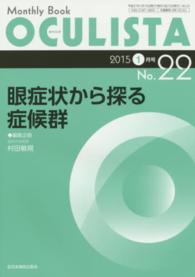- ホーム
- > 洋書
- > 英文書
- > History / World
基本説明
If there was a unique pathway of industrialization, it was less a distinct entrepreneurial and techno-centric culture, than one predominantly defined within an institutional framework spearheaded by the excise and a wall of tariffs.
Full Description
Asis book traces the growth of customs and excise, and their integral role in shaping the framework of industrial England; including state power, technical advance, and the evolution of a consumer society. Central to this structure was the development of two economies - one legal and one illicit. If there was a unique English pathway of industrialization, it was less a distinct entrepreneurial and techno-centric culture, than one predominantly defined within an institutional framework spearheaded by the excise and a wall of tariffs. This process reached its peak by the end of the 1770s. The structure then quickly started to crumble under the weight of the fiscal-military state, and Pitt's calculated policy of concentrating industrial policy around cotton, potteries, and iron - at the expense of other taxed industries. The breakthrough of the new political economy was the erosion of the illicit economy; the smugglers' free trade now became the state's most powerful weapon in the war against non-legal trade. If at the beginning of the period covered by this book state administration was predominantly deregulated and industry regulated, by the close the reverse was the case.
Contents
Abbreviations ; Acknowledgements ; Introduction ; PART I: CONSUMING THE PEOPLE ; 1. The Emergence of Public Credit: War, Revenue, and High Politics ; 2. The "Consumptibility" of Goods: Customs, Excise, and Trade ; 3. The Equitable Tax? ; 4. Liberty, Property, and the Excise ; PART II: THE "DEVIL'S REMEDY" ; 5. Delusion? Public Credit, Trust, and the Excise ; 6. The Introduction of the Excise ; 7. "His leering eyes gives such a look": The World of Excise ; PART III: AN IMPOLITE AND COMMERCIAL PEOPLE - THE COMMON ECONOMY ; 8. Life on the Waterfront ; 9. Pilfering, Custom Fees, and Renumeration ; 10. Smuggling ; 11. Free Trade, Transport, and Concealment ; PART IV: EXCISE, FRAUD, AND PRODUCTION ; 12. Drink and Food ; 13. Candles, Soap, Salt, Starch, Leather, Paper, Textiles, and Glass ; PART V: SHAPING AND REGULATING THE MARKET ; 14. Measurement, Instrumentation, and Alcohol Standards ; 15. Revenue, Metrology, and Casks ; 16. The Incarceration, Adulteration, and Policing of Taxed Goods ; PART VI: DISMANTLING THE FISCAL-MILITARY STATE ; 17. The Limits of Taxation and the Politics of Representation ; 18. Revenue, "Old Corruption", and Manufacturing Interests ; 19. "Simplicity, Uniformity, and Perspicuity" ; 20. "The Calcio Millennium" ; Index








